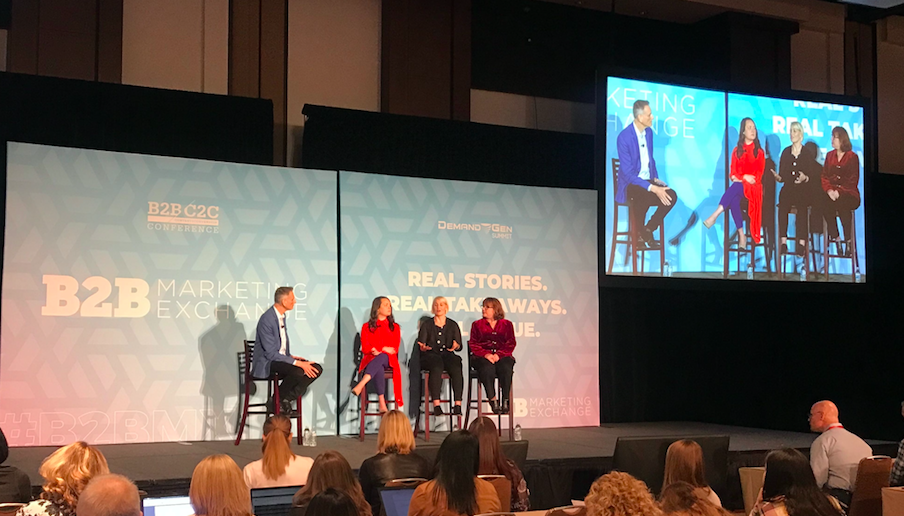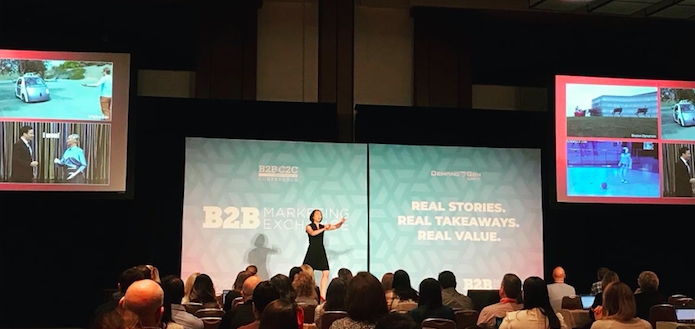B2B marketers react to the thought of artificial intelligence (AI) in different ways, said Pam Didner of Relentless Pursuit LLC. Pessimists may envision dystopian universes as portrayed in the Terminator, Blade Runner or The Matrix; optimists may picture R2D2 or Data from Star Trek: The Next Generation. Whichever attitude marketers take, “AI is not a fad. It’s here to stay,” declared Didner in her keynote address, How AI Is Already Impacting Every Stage of Buyer Engagement, which explored how B2B marketers currently use AI and looked ahead to the technology’s future.
The first step to understanding what AI means for our industry is to agree on a definition, said Didner, who defined AI as “intelligence exhibited by machines to enable decision-making, predict outcomes or improve efficiency.” Currently, she explained, we’re in the era of narrow AI, which can handle a task competently and modify its behavior as situations change. Siri, autonomous cars or Google Home are examples of how most of us use narrow AI in daily life.
Further out on the horizon, general AI (AGI) will be able to perform any intellectual task humans can do. Ultimately, Didner said, super AI (ASI) will outperform even the best human brains in every field, including creative pursuits and social interactions.
What are B2B marketers currently using AI for? A better question might be, What aren’t they using it for? A typical marketer’s AI-powered workday might include using AI tools to find an optimal title for content, generate creative ideas, create content and syndicate that content to multiple channels. Marketers also use AI to follow up with prospects via email, sort prospect inquiries for handoff to humans. AI can record sales engagements and determine sentiment, forecast revenue and project closure rates. AI can even personalize gifting, said Didner, citing one vendor whose AI solution crawls a prospect’s social profile to determine the best gift for that person.
While many organizations are implementing AI at basic levels, such as chatbots, sales agents and marketing assistants, the technology has much more potential for B2B marketers. Didner shared several examples of AI tools that, while not widely used, have exciting B2B business applications.
- The Washington Post’s proprietary AI content creation tool, Hellograf, uses editor-created templates to search for reliable data sources, write and publish content. In 2016, Hellograf wrote 850 articles that generated half a million views. Quill, a similar app, is available for businesses.
- Creating customer testimonial videos is tedious and expensive, often involving lots of scheduling, travel and time. “What if you could virtually clone the [customer] and use that instead?” asked Didner, screening a video from Hour One, whose platform builds synthetic characters into its video production capabilities. After the video ended, she revealed that the two “people” in the video were actually synthetic characters.
- AI is even entering what Didner humorously called “the human’s final frontier” — generating creative ideas. She screened two Japanese TV commercials — one written by an award-winning human director, the other written by an AI app that had ingested 10 years’ worth of award-winning TV commercials. Human subjects preferred the human-created commercial — but only by a narrow margin, she said.
While none of these AI technologies will replace humans, Didner said, they can make B2B marketers more efficient and effective. Ultimately, they have the potential to do much more.
“The holy grail of B2B marketing is that we want to reach our customers at the time they’re ready to buy,” Didner said. “Many platforms say they will do this but fail miserably. I think AI may actually have a shot at helping us reach that holy grail.”
Urging the audience to kick off their own AI initiatives, Didner shared three steps to doing so:
- Articulate: Identify one to three big, thorny challenges you want to use AI to solve.
- Communicate: Hold an internal conversation, top-down and bottom-up, to identify possible AI solutions. These may be internal, external or a hybrid approach.
- Incorporate: Include discussion around AI in your annual planning and allocate budget accordingly to make it happen.
The potential of AI is only beginning to unfold, said Didner, reminding B2B marketers who may be on the fence that “all initiatives are about experimentation, and everything digital can be undone.” By using good data and setting expectations to prepare management for failures as well as successes, forward-thinking B2B marketers can implement AI solutions that may one day be as indispensable to their organizations as R2D2 was to Luke Skywalker.
Redefining The Way B2B Marketers Create & Amplify Content

Whether content is created by humans or by AI, speakers at #B2BMX sounded a common theme: In order to attract and maintain attention, the type of content marketers create must undergo a transformation. Many B2B brands are looking to media brands for inspiration. In From Content Producers To Media Brands: How B2B Companies Are Redefining the Way They Create and Amplify Content, Mark Bornstein, VP of Content Marketing at ON24, convened three leading marketing professionals to discuss this trend.
Creating an editorial voice can help B2B brands make an emotional impact on customers, said Lynne Sampson, Managing Editor for Oracle’s The Modern Finance Leader, citing the passion Fox News incites with its strong point of view.
“Brands often establish great brand guidelines [for their visual branding] but don’t include voice and tone,” noted Anna Hrach, Strategist at Convince & Convert.
In addition, while the marketing team may have a firm grasp on the editorial voice, it’s vital to ensure that it carries throughout the organization.
Is written content dead? Sampson, whose Modern Finance Leader publishes one article daily, contends, “There is still a place for the written word; it just needs to be shorter and more informative. Tying content to news topics that are very topical will catch people’s attention in a way that a white paper will not.” A former journalist, Sampson said B2B marketing content doesn’t need to rival a newsroom’s in topicality. However, she advised B2B brands to stay on top of news and trends in their industry, consider how it will affect their customers and create relevant content about it.
Matching the message, format and channel to the audience is key to successful content creation, the panelists agreed. “Ask yourself what is the right fit for your brand and what is the right style for the product you’re trying to sell,” advised Elizabeth Giorgi, co-founder and CEO of soona. For example, soona recently created a series of videos targeting Millennials and designed the content specifically for Instagram. “The kind of video people want to watch on YouTube is completely different from what they want to watch on Instagram,” Giorgi explained.
Whether marketers are producing written content or video, thinking like a broadcaster can help. Too many B2B organizations are guilty of “random acts of content — a white paper here, a blog post there, but nothing cohesive,” said Hrach. To avoid this pitfall, she said, Convince & Convert structures their editorial calendar by thinking like a TV network. “We have three types of content: binge-worthy content, which we do a few times a month; quarterly ‘specials’; and our regularly scheduled programming, such as blogs.” This approach ensures a consistent cadence of content but also enables the flexibility to create new content “on the fly” when timely topics arise.
How much new content do organizations actually need to create?
“Everybody is generating huge garbage piles of content. It just creates more noise,” said Giorgi, whose viewpoint clearly resonated with the audience. “A lot of your content is like old socks. Quit trying to organize them.”
Keeping old content on your site may boost SEO, Giorgi noted, but how does it help your brand? “Prioritize the cream of the crop your organization has to offer,” she urged. “Throw out the old socks. Throw out anything in the middle, too. You want to put your best foot forward on the Internet, not a mediocre foot forward. My challenge to you: Do less and have it mean more.”







